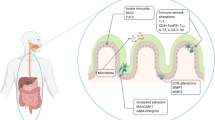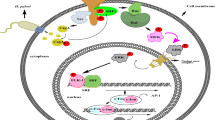Abstract
Background
Uncontrolled cell proliferation and suppressed apoptosis are the critical events transforming a normal cell to a cancerous one wherein the inflammatory microenvironment supports this oncogenic transformation. The process of colon carcinogenesis may be aggravated in chronic inflammatory conditions such as ulcerative colitis where non-steroidal anti-inflammatory drugs (NSAIDs) may effectively prevent the cellular and molecular events.
Methods
Western blots and immunofluorescent analysis of DNA mismatch repair enzymes, cell cycle regulators and pro- and anti-apoptotic proteins were performed in dextran sulfate sodium (DSS)-induced ulcerative colitis and 1,2-dimethyl benz(a)anthracene (DMH)-induced colon cancer. Also, apoptotic studies were done in isolated colonocytes using fluorescent staining and in paraffin sections using TUNEL assay.
Results
An upregulation of cell cycle regulators: cyclin D1/cdk4 and cyclin E/cdk2 and anti-apoptotic Bcl-2, along with the suppression of DNA repair enzymes: MLH1 and MSH2; tumour suppressors: p53, p21and Rb and pro-apoptotic proteins: Bax and Bad were observed in the DSS, DMH and DSS + DMH groups. Proliferating cell nuclear antigen (PCNA) was also overexpressed in these groups. The ultimate executioner of the apoptotic pathway; caspase-3, was suppressed in these groups. Apoptotic studies in colonocytes and paraffin sections revealed suppressed apoptosis in these groups. These effects were corrected with the administration of a second generation NSAID, celecoxib along with the treatment of DSS and DMH.
Conclusion
The chemopreventive action of celecoxib in colitis mediated colon carcinogenesis may include the regulation of DNA mismatch repair enzymes, cell cycle check points, cell proliferation and apoptosis.
Similar content being viewed by others
References
Hussain SP, Harris CC. Inflammation and cancer: an ancient link with novel potentials. Int J Cancer 2007;121(11):2373–80.
Das PM, Singal R. DNA methylation and cancer. J Clin Oncol 2004;22(22):4632–42.
Fleisher AS, Esteller M, Harpaz N, Leytin A, Rashid A, Xu Y, et al. Microsatellite instability in inflammatory bowel disease-associated neoplastic lesions is associated with hypermethylation and diminished expression of the DNA mismatch repair gene, hMLH1. Cancer Res 2000;60(17):4864–8.
Dong CX, Deng DJ, Pan KF, Zhang L, Zhang Y, Zhou J, et al. Promoter methylation of p16 associated with Helicobacter pylori infection in precancerous gastric lesions: a population-based study. Int J Cancer 2009;124(2):434–9.
Mantovani A, Romero P, Palucka AK, Marincola FM. Tumour immunity: effector response to tumour and role of the microenvironment. Lancet 2008;371(9614):771–83.
Rakoff-Nahoum S. Why cancer and inflammation? Yale J Biol Med 2006;79(3–4):123–30.
Jana NR. NSAIDs and apoptosis. Mol Life Sci 2008;65(9):1295–301.
Castedo M, Perfettini JL, Roumier T, Kroemer G. Cyclin-dependent kinase-1: linking apoptosis to cell cycle and mitotic catastrophe. Cell Death Differ 2002;9(12):1287–93.
Keith A, Alexander J, Julian L, Roberts MR, Peter W. Apoptosis: programmed cell death eliminates unwanted cells. In: Molecular biology of the cell. 5th ed, New York: Garland Science; 2008 [chapter 18].
Evan GI, Vousden KH. Proliferation, cell cycle and apoptosis in cancer. Nature 2001;411(6835):342–8.
Weaver BA, Cleveland DW. Decoding the links between mitosis, cancer, and chemotherapy: the mitotic checkpoint, adaptation, and cell death. Cancer Cell 2005;8(July (1):7–12.
Neganova I, Lako M. G1 to S phase cell cycle transition in somatic and embryonic stem cells. J Anat 2008;213(1):30–44.
Gartel AL, Tyner AL. The role of the cyclin-dependent kinase inhibitor p21 in apoptosis. Mol Cancer Ther 2002;1(8):639–49.
Hall M, Peters G. Genetic alterations of cyclins, cyclin-dependent kinases, and Cdk inhibitors in human cancer. Adv Cancer Res 1996;68:67–108.
Trivedi PP, Jena GB. Dextran sulfate sodium-induced ulcerative colitis leads to increased hematopoiesis and induces both local as well as systemic genotoxicity in mice. Mutat Res 2012;744(2):172–83.
Setia S, Sanyal SN. Upregulation of intrinsic apoptotic pathway in NSAIDs mediated chemoprevention of experimental lung carcinogenesis. Pharmacol Rep 2012;64(3):615–24.
Setia S, Vaish V, Sanyal SN. Chemopreventive effects of NSAIDs as inhibitors of cyclooxygenase-2 and inducers of apoptosis in experimental lung carcinogenesis. Mol Cell Biochem 2012;366(1–2):89–99.
Roediger WE, Truelove SC. Method of preparing isolated colonic epithelial cells (colonocytes) for metabolic studies. Gut 1979;20(6):484–8.
Toivola DM, Krishnan S, Binder HJ, Singh SK, Omary MB. Keratins modulate colonocyte electrolyte transport via protein mistargeting. J Cell Biol 2004;164(6):911–21.
Yuan Y, Zhi-Qiang GE, Jing-Chuan L. Differentiation of apoptotic and necrotic cells in suspension cultures of Taxus cuspidate by the combined use of fluorescent dying and histochemical staining methods. Biotechnol Lett 2002;24(1):7–76.
Baker AJ, Mooney A, Hughes J, Lombardi D, Johnson RJ, Savill J. Mesangial cell apoptosis: the major mechanism for resolution of glomerular hypercellularity in experimental mesangial proliferative nephritis. J Clin Invest 1994;94(5):2105–16.
Bertoli C, Skotheim JM, de Bruin RA. Control of cell cycle transcription during G1 and S phases. Nat Rev Mol Cell Biol 2013;14(8):518–28.
Planas-Silva MD, Weinberg RA. The restriction point and control of cell proliferation. Curr Opin Cell Biol 1997;9(6):768–72.
Bloom J, Pagano M. Deregulated degradation of the cdk inhibitor p27 and malignant transformation. Semin Cancer Biol 2003;13(1):41–7.
Zhang MF, Zhang ZY, Fu J, Yang YF, Yun JP. Correlation between expression of p53, p21/WAF1, and MDM2 proteins and their prognostic significance in primary hepatocellular carcinoma. J Transl Med 2009;7:110.
Yonish-Rouach E, Resnitzky D, Lotem J, Sachs L, Kimchi A, Oren M. Wildtype p53 induces apoptosis of myeloid leukaemic cells that is inhibited by interleukin-6. Nature 1991;352(6333):345–7.
Eizenberg O, Faber-Elman A, Gottlieb E, Oren M, Rotter V, Schwartz M. Direct involvement of p53 in programmed cell death of oligodendrocytes. EMBO J 1995;14(6):1136–44.
Miyashita T, Krajewski S, Krajewska M, Wang HG, Lin HK, Liebermann DA, et al. Tumor suppressor p53 is a regulator of bcl-2 and bax gene expression in vitro and in vivo. Oncogene 1994;9(6):1799–805.
Chipuk JE, Bouchier HL, Green DR. Mitochondrial outer membrane permeabilization during apoptosis: the innocent bystander scenario. Cell Death Differ 2006;13(8):1396–402.
Oberst A, Bender C, Green DR. Living with death: the evolution of the mitochondrial pathway of apoptosis in animals. Cell Death Differ 2008;15(7):1139–46.
Balkwill F, Mantovani A. Inflammation and cancer: back to Virchow? Lancet 2002;357(9255):539–45.
Jung YJ, Isaacs JS, Lee S, Trepel J, Neckers L. IL-1beta-mediated up-regulation of HIF-1alpha via an NFkappaB/COX-2 pathway identifies HIF-1 as a critical link between inflammation and oncogenesis. FASEB J 2003;17(14):2115–7.
Cobbs CS, Whisenhunt TR, Wesemann DR, Harkins LE, Van Meir EG, Samanta M. Inactivation of wild-type p53 protein function by reactive oxygen and nitrogen species in malignant glioma cells. Cancer Res 2003;63(24):8670–3.
Jaiswal M, LaRusso NF, Gores GJ. Nitric oxide in gastrointestinal epithelial cell carcinogenesis: linking inflammation to oncogenesis. Am J Physiol Gastrointest Liver Physiol 2001;281(3):G626–34.
Ying L, Marino J, Hussain SP, Khan MA, You S, Hofseth AB, et al. Chronic inflammation promotes retinoblastoma protein hyperphosphorylation and E2F1 activation. Cancer Res 2005;65(20):9132–6.
Ying L, Hofseth AB, Browning DD, Nagarkatti M, Nagarkatti PS, Hofseth LJ. Nitric oxide inactivates the retinoblastoma pathway in chronic inflammation. Cancer Res 2007;67(19):9286–93.
Hillario NOE, Terrari MT, Len CA. Nonsteroidal anti-inflammatory drugs: cyclooxygenase 2 inhibitors. J Pediatr (Rio J) 2006;82(Suppl. 5):S206–12.
Haynes A, Shaik MS, Chatterjee A, Singh M. Evaluation of an aerosolized selective COX-2 inhibitor as a potentiator of doxorubicin in a non-small-cell lung cancer cell line. Pharm Res 2003;20(9):1485–95.
Author information
Authors and Affiliations
Corresponding author
Rights and permissions
About this article
Cite this article
Setia, S., Nehru, B. & Sanyal, S.N. Celecoxib prevents colitis associated colon carcinogenesis: An upregulation of apoptosis. Pharmacol. Rep 66, 1083–1091 (2014). https://doi.org/10.1016/j.pharep.2014.07.001
Received:
Revised:
Accepted:
Published:
Issue Date:
DOI: https://doi.org/10.1016/j.pharep.2014.07.001




